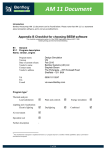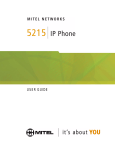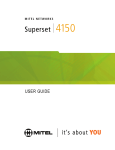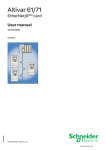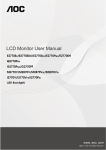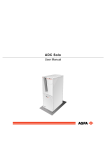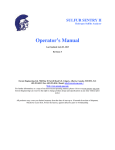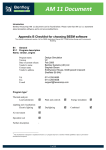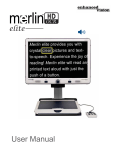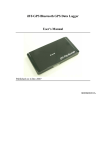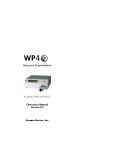Download Using Explicit Messaging
Transcript
EtherNet/IP Adapter 22-COMM-E FRN 1.xxx User Manual Chapter 6 Using Explicit Messaging Chapter 6 provides information and examples that explain how to use Explicit Messaging to configure and monitor the EtherNet/IP adapter installed and connected to the PowerFlex 40 drive. Topic About Explicit Messaging Formatting Explicit Messages Performing Explicit Messages ! ! Page 6-1 6-2 6-4 Topic About the Example Explicit Messages Example Get Attribute Single Message Example Set Attribute Single Message Page 6-5 6-6 6-8 ATTENTION: Risk of injury or equipment damage exists. The examples in this publication are intended solely for purposes of example. There are many variables and requirements with any application. Rockwell Automation, Inc. does not assume responsibility or liability (to include intellectual property liability) for actual use of the examples shown in this publication. ATTENTION: Risk of equipment damage exists. If Explicit Messages are programmed to write parameter data to Non-Volatile Storage (NVS) frequently, the NVS will quickly exceed its life cycle and cause the drive to malfunction. Do not create a program that frequently uses Explicit Messages to write parameter data to NVS. Refer to Chapter 5 for information about the I/O image, using Logic Command/Status and Reference/Feedback. About Explicit Messaging Explicit Messaging is used to transfer data that does not require continuous updates. With Explicit Messaging, you can configure and monitor a slave device’s parameters on the EtherNet/IP network. 6-2 Using Explicit Messaging Formatting Explicit Messages Explicit Messages for the ControlLogix Controller ControlLogix scanners and bridges accommodate both downloading Explicit Message Requests and uploading Explicit Message Responses. The scanner or bridge module can accommodate one request or response for each transaction block. Each transaction block must be formatted as shown in Figure 6.1. Figure 6.1 ControlLogix Message Format in RSLogix 5000 11 ➓ ➊ ➋ ➌ ➎ ➍ ➏ ➐ ➑ ➒ Refer to page 6-3 for a description of the data that is required in each box (1 – 11). TIP: To display the Message Configuration dialog box in RSLogix 5000, add a message instruction (MSG), create a new tag for the message (properties: Base tag type, MESSAGE data type, controller scope), and click the blue box inside the message. Using Explicit Messaging 6-3 ControlLogix Message Requests and Responses Box Description ➊ Message Type The message type must be CIP Generic. ➋ Service Type The service type indicates the service (for example, Get Attribute Single or Set Attribute Single) that you want to perform. Available services depend on the class and instance that you are using. Refer to Appendix C, EtherNet/IP Objects. ➌ Service Code The service code is the code for the requested EtherNet/IP service. This value changes based on the Service Type that has been selected. In most cases, this is a read-only box. If you select “Custom” in the Service Type box, then you need to specify a service code in this box (for example, 4B for a Get Attributes Scattered service or 4C for a Set Attributes Scattered service). ➍ Class The class is an EtherNet/IP class. Refer to Appendix C, EtherNet/IP Objects, for available classes. ➎ Instance The instance is an instance (or object) of an EtherNet/IP class. Refer to Appendix C, EtherNet/IP Objects, for available instances for each class. ➏ Attribute The attribute is a class or instance attribute. Refer to Appendix C, EtherNet/IP Objects, for available attributes for each class or instance. ➐ Source Element This box contains the name of the tag for any service data to be sent from the scanner or bridge to the adapter and drive. ➑ Source Length This box contains the number of bytes of service data to be sent in the message. ➒ Destination This box contains the name of the tag that will receive service response data from the adapter and drive. ➓ Path The path is the route that the message will follow. 11 Tip: Click Browse to find the path or type in the name of an adapter that you previously mapped. Name The name for the message. 6-4 Using Explicit Messaging Performing Explicit Messages There are five basic events in the Explicit Messaging process. The details of each step will vary depending on the controller. Refer to the documentation for your controller. Figure 6.2 Explicit Message Process ➊ ➎ Complete Explicit Message ➍ Retreive Explicit Message Respnse Set up and send Explicit Message Request ➋ ➌ Event 1. You format the required data and set up the ladder logic program to send an Explicit Message request to the scanner or bridge module (download). 2. The scanner or bridge module transmits the Explicit Message Request to the slave device over the Ethernet network. 3. The slave device transmits the Explicit Message Response back to the scanner. The data is stored in the scanner buffer. 4. The controller retrieves the Explicit Message Response from the scanner’s buffer (upload). 5. The Explicit Message is complete. Using Explicit Messaging 6-5 About the Example Explicit Messages These examples show how to format and execute the following types of Explicit Messages using a ControlLogix controller: • Get Attribute Single • Set Attribute Single Message Formats When formatting an example message, refer to Formatting Explicit Messages in this chapter for an explanation of the content of each box. Also, to format and execute these example messages, you need the Controller tags displayed in Figure 6.3. Figure 6.3 Controller Tags for Explicit Messages Ladder Logic Rungs The ladder logic rungs for the examples in this chapter can be appended after rung 12 in the ladder logic program (Figure 5.5) in Chapter 5, Using I/O Messaging. Source and Destination Data The example values for the source and destination data that appear in this chapter may vary in your application. 6-6 Using Explicit Messaging Example Get Attribute Single Message A Get Attribute Single message reads a single attribute value. In this example, we read the value of a parameter in a PowerFlex 40 drive. Example Message Format Figure 6.4 Message Format for a Get Attribute Single Message The following table identifies key settings for the message format: Configuration Service Type (1) Service Code (1) Class Instance Attribute Destination (1) Value Get Attribute Single e (Hex.) f (Hex.) 39 (Dec.) 1 (Hex.) ParameterReadValue Description Read parameter data Get_Attribute_Single DSI Parameter Object Parameter 39 - [Accel Time 1] Parameter Value Controller tag for response data Refer to . . . C-27 C-12 C-24 C-24 C-25 — The default setting for Service Type is “Custom,” which enables you to enter a Service Code that is not available from the Service Type pulldown menu. When you select a Service Type other than “Custom” from the pulldown menu, an appropriate Hex. value is automatically assigned to the Service Code box which grays out (unavailable). Using Explicit Messaging 6-7 Example Ladder Logic Rung Figure 6.5 Example Get Attribute Single Message ([SOLFLW0HVVDJLQJ([DPSOH ([SOLFLW0HVVDJLQJ([DPSO 5HDGLQJDVLQJOHSDUDPHWHU*HW$WWULEXWH6LQJOHFRPPDQG 3HUIRUP3DUDPHWHU5HDG 7\SH&,3*HQHULF 0HVVDJH&RQWURO 06* 3DUDPHWHU5HDG0HVVDJH (1 '1 (5 Example Destination Data In this example, the Get Attribute Single message reads Parameter 39 [Accel Time 1] in the PowerFlex 40 drive and returns its value to the destination tag named ParameterReadValue. Figure 6.6 Example Destination Data from a Get Attribute Single Message The acceleration time is 10.0 seconds. 6-8 Using Explicit Messaging Example Set Attribute Single Message A Set Attribute Single message writes a value for a single attribute. In this example, we write the value of a parameter in a PowerFlex 40 drive. Example Message Format Figure 6.7 Message Format for a Set Attribute Single Message The following table identifies key settings for the data format: Configuration Service Type (1) Service Code (1) Class Instance Attribute Source Element Source Length (1) Value Set Attribute Single 10 (Hex.) f (Hex.) 39 (Dec.) 1 (Hex.) ParameterWriteValue 2 bytes Description Write parameter data Set_Attribute_Single DSI Parameter Object Parameter 39 - [Accel Time 1] Parameter Value Controller tag for write data One 16-bit word of data is sent Refer to . . . C-27 C-12 C-24 C-24 C-25 — — The default setting for Service Type is “Custom,” which enables you to enter a Service Code that is not available from the Service Type pulldown menu. When you select a Service Type other than “Custom” from the pulldown menu, an appropriate Hex. value is automatically assigned to the Service Code box which grays out (unavailable). Using Explicit Messaging 6-9 Example Ladder Logic Rung Figure 6.8 Example Set Attribute Single Message ([SOLFLW0HVVDJLQJ([DPSOH :ULWLQJDVLQJOHSDUDPHWHU6HW$WWULEXWH6LQJOHFRPPDQG 3HUIRUP3DUDPHWHU:ULWH 7\SH&,3*HQHULF 0HVVDJH&RQWURO 06* 3DUDPHWHU:ULWH0HVVDJH (1 '1 (5 Example Source Data In this example, the Set Attribute Single message writes 100, the value in the source tag named ParameterWriteValue, to Parameter 39 - [Accel Time 1] in the PowerFlex 40 drive. Figure 6.9 Example Source Data from a Set Attribute Single Message 10.0 seconds is written to the parameter. 6-10 Notes: Using Explicit Messaging Appendix C EtherNet/IP Objects Appendix C provides information about the EtherNet/IP objects that can be accessed using Explicit Messages. For information on the format of Explicit Messages and example ladder logic programs, refer to Chapter 6, Using Explicit Messaging. Object Identity Object Assembly Object Register Object Parameter Object Parameter Group Object PCCC Object Class Code Hex. Dec. 0x01 1 0x04 4 0x07 7 0x0F 15 0x10 16 0x67 103 Page C-2 C-4 C-6 C-9 C-13 C-15 Object DPI Device Object DPI Parameter Object DPI Fault Object DPI Diagnostic Object TCP/IP Interface Object Ethernet Link Object Class Code Hex. Dec. 0x92 146 0x93 147 0x97 151 0x99 153 0xF5 245 0xF6 246 Page C-21 C-24 C-28 C-30 C-32 C-34 TIP: Refer to the EtherNet/IP specification for more information about EtherNet/IP objects. Information about the EtherNet/IP specification is available on the ODVA web site (http://www.odva.org). Supported Data Types Data Type BYTE WORD DWORD LWORD SINT USINT INT UINT DINT UDINT BOOL BOOL[n] STRING[n] SHORT_STRING STRUCT CONTAINER TCHAR REAL Description 8-bit unsigned integer 16-bit unsigned integer 32-bit unsigned integer 64-bit unsigned integer 8-bit signed integer 8-bit unsigned integer 16-bit signed integer 16-bit unsigned integer 32-bit signed integer 32-bit unsigned integer 8-bit value -- low bit is true or false Array of n bits Array of n characters 1-byte length indicator + that many characters Structure name only - no size in addition to elements 32-bit parameter value - sign extended if necessary 8 or 16-bit character 32-bit floating point C-2 EtherNet/IP Objects Identity Object Class Code Hexadecimal 0x01 Decimal 1 Instances (Single-Drive Mode) The number of instances is fixed at three and is as shown below: Instance 0 1 2 3 Description Class Host drive 22-COMM-E 22-SCM-232 or 22-HIM-* (when present) Instances (Multi-Drive Mode) The number of instances is fixed at one and is as shown below: Instance 0 1 Description Class 22-COMM-E Class Attributes Attribute ID 1 2 6 Access Rule Get Get Get 7 Get Name Revision Max Instance Max ID Number of Class Attributes Max ID Number of Instance Attributes Data Type UINT UINT UINT Description 1 Total number of instances 7 UINT 100 EtherNet/IP Objects C-3 Identity Object (Continued) Instance Attributes Attribute ID 1 2 3 Acces s Rule Get Get Get 4 Get 5 Get 6 7 Get Get 9 Get 100 Get Name Vendor ID Device Type Product Code Data Type UINT UINT UINT Revision: Major Minor Status STRUCT of: USINT USINT WORD Description 1 = Allen-Bradley 127 Number identifying product name and rating Serial Number UDINT Product Name SHORT_ STRING Configuration UINT Consistency Value NVS Info STRUCT of: UDINT SHORT_STRING Value varies Value varies Bit 0 = Owned Bit 2 = Configured Bit 10 = Recoverable fault Bit 11 = Unrecoverable fault Unique 32-bit number Product name and rating CRC or checksum representing the configuration of the product First NVS instance Sub-assembly name Services Service Code 0x01 0x05 0x0E Implemented for: Class Instance Yes Yes No Yes Yes Yes Service Name Get_Attributes_All Reset Get_Attribute_Single C-4 EtherNet/IP Objects Assembly Object Class Code Hexadecimal 0x04 Decimal 4 Instances Instance 1 2 Description All I/O data being read from the DSI drives (read-only) All I/O data written to the DSI drives (read/write) Class Attributes Attribute ID 1 2 100 Access Rule Get Get Set Name Revision Max Instance Control Timeout Data Type UINT UINT UINT Description 2 2 Control timeout in seconds Name Number of Members Member List Data Type UINT Description 1 Instance Attributes Attribute ID Access Rule 1 Get 2 3 4 (1) Get Conditional (1) Data Get Size ARRAY of STRUCT: UINT UINT Packed EPATH Array of Bits UINT Size of member data Size of member path Member path Data to be transferred Size of assembly data in bits For instance 1, access rule for the data attribute is Get. For instance 2, it is Get/Set. Important: Setting an Assembly object attribute can be done only when the Control Timeout (class attribute 100) has been set to a non-zero value. EtherNet/IP Objects Assembly Object (Continued) Services Service Code 0x0E 0x10 Implemented for: Class Instance Yes Yes Yes Yes Service Name Get_Attribute_Single Set_Attribute_Single C-5 C-6 EtherNet/IP Objects Register Object Class Code Hexadecimal 0x07 Decimal 7 Instances Instance Description 1 2 3 4 5 6 7 8 9 10 11 12 13 14 15 16 17 18 19 20 21 22 23 24 25 26 Logic Command and Reference for all drives Logic Status and Feedback for all drives Logic Command and Reference for Drive 0 Logic Status and Feedback for Drive 0 Logic Command and Reference for Drive 1 Logic Status and Feedback for Drive 1 Logic Command and Reference for Drive 2 Logic Status and Feedback for Drive 2 Logic Command and Reference for Drive 3 Logic Status and Feedback for Drive 3 Logic Command and Reference for Drive 4 Logic Status and Feedback for Drive 4 Logic Command for all drives — mask-and-match register (2) Logic Command for Drive 0 — mask-and-match register (2) Logic Command for Drive 1 — mask-and-match register (2) Logic Command for Drive 2 — mask-and-match register (2) Logic Command for Drive 3 — mask-and-match register (2) Logic Command for Drive 4 — mask-and-match register (2) Logic Command for Drive 0 Logic Status for Drive 0 Reference for Drive 0 Feedback for Drive 0 Logic Command for Drive 1 Logic Status for Drive 1 Reference for Drive 1 Feedback for Drive 1 Input/ Output Out In Out In Out In Out In Out In Out In Out Out Out Out Out Out Out In Out In Out In Out In Size (in bits) Varies (1) Varies (1) 32 32 32 32 32 32 32 32 32 32 Varies (1) 32 32 32 32 32 16 16 16 16 16 16 16 16 (1) The size for this Register Object instance is 32 bits per drive. For example, if the adapter is operating in Multi-Drive mode, and is configured with Drives 0 through 4, then the size is 160 bits. (2) The structure for this Register Object instance is a Mask word followed by a Command word for each drive. The Logic Command for each drive is set to the value of the second word of the data where there are ones in the first word of the data. Logic Command = (Logic Command and not Mask word) or (Command word and Mask word) EtherNet/IP Objects C-7 Register Object (Continued) Instances (Continued) Input/ Output Out In Out In Out In Out In Out In Out In Instance Description 27 28 29 30 31 32 33 34 35 36 37 38 Logic Command for Drive 2 Logic Status for Drive 2 Reference for Drive 2 Feedback for Drive 2 Logic Command for Drive 3 Logic Status for Drive 3 Reference for Drive 3 Feedback for Drive 3 Logic Command for Drive 4 Logic Status for Drive 4 Reference for Drive 4 Feedback for Drive 4 Size (in bits) 16 16 16 16 16 16 16 16 16 16 16 16 Class Attributes Attribute ID 1 2 3 100 Access Rule Get Get Get Set Name Revision Max Instance Number of Instances Control Timeout Data Type UINT UINT UINT UINT Description 1 38 38 Control timeout in seconds C-8 EtherNet/IP Objects Register Object (Continued) Instance Attributes Attribute ID Access Rule 1 Get Name Bad Flag 2 Get Direction 3 4 Get Size Conditional (1) Data (1) Data Type Description BOOL If set to 1, then attribute 4 contains invalid, bad or otherwise corrupt data. 0 = good 1 = bad BOOL Direction of data transfer 0 = Input (Drive to EtherNet/IP) 1 = Output (EtherNet/IP to Drive) UINT Size of register data in bits ARRAY of Data to be transferred BITS The access rule of Set is optional if attribute 2, Direction = 1. If Direction = 0, the access rule is Get. Important: Setting a Register object attribute can be done only when the Control Timeout (class attribute 100) has been set to a non-zero value. Service Code 0x0E 0x10 Implemented for: Class Instance Yes Yes Yes Yes Service Name Get_Attribute_Single Set_Attribute_Single EtherNet/IP Objects C-9 Parameter Object Class Code Hexadecimal 0x0F Decimal 15 Instances (Single-Drive Mode) The number of instances is as shown below: Instance 0 1 R n n+1 R n+m (1) (2) Description Class Drive Parameter 1 R Drive Parameter n (1) Adapter Parameter 1 R Adapter Parameter m (2) n represents the number of parameters in the drive. m represents the number of parameters in the adapter. Instances (Multi-Drive Mode) The number of instances is as shown below: Instance 0 1 R m (1) Description Class Adapter Parameter 1 R Adapter Parameter m (1) m represents the number of parameters in the adapter. In addition, the parameters for the other DSI devices can be accessed using the instance-offset encoding shown in the table below: Instances (Dec.) 16384 – 17407 17408 – 18431 18432 – 19455 19456 – 20479 20480 – 21503 21504 – 22527 Single-Drive Mode Instances 0 – 1023 in the adapter Instances 0 – 1023 in the drive Not supported Not supported Not supported Not supported Multi-Drive Mode Instances 0 – 1023 in the adapter Instances 0 – 1023 in Drive 0 Instances 0 – 1023 in Drive 1 Instances 0 – 1023 in Drive 2 Instances 0 – 1023 in Drive 3 Instances 0 – 1023 in Drive 4 C-10 EtherNet/IP Objects Parameter Object (Continued) Class Attributes Attribute ID 1 2 8 Access Rule Get Get Get 9 Get 10 Get Name Revision Max Instance Parameter Class Descriptor Data Type UINT UINT WORD Configuration Assembly Instance Native Language UINT USINT Description 1 Number of parameters 0 = False, 1 = True Bit 0 = Supports parameter instances Bit 1 = Supports full attributes Bit 2 = Must do NVS save command Bit 3 = Parameters are stored in NVS 0 0 = English 1 = French 2 = Spanish 3 = Italian 4 = German 5 = Japanese 6 = Portuguese 7 = Mandarin Chinese 8 = Russian 9 = Dutch EtherNet/IP Objects C-11 Parameter Object (Continued) Instance Attributes Attribute Access ID Rule Name (1) 1 Parameter Value 2 Get Link Path Size Data Type Description (2) (3) USINT 0 = No link specified n = The size of Attribute 3 in bytes 0 = False, 1 = True Bit 1 = Supports ENUMs Bit 2 = Supports scaling Bit 3 = Supports scaling links Bit 4 = Read only Bit 5 = Monitor Bit 6 = Extended precision scaling 0xC2 = SINT (8-bits) 0xC3 = INT (16-bits) 0xC4 = DINT (32-bits) 0xC6 = USINT (8-bits) 0xC7 = UINT (16-bits) 0xCA = REAL (32-bits) 0xD2 = WORD (16-bits) (4) 3 4 Get Get Link Path Descriptor WORD 5 Get Data Type USINT 6 7 Get Get 8 Get Data Size Parameter Name String Units String 9 Get Help String (3) USINT SHORT_ (3) STRING SHORT_ (3) STRING SHORT_ Null string STRING 10 11 12 13 14 15 16 17 18 19 20 21 Get Get Get Get Get Get Get Get Get Get Get Get Minimum Value Maximum Value Default Value Scaling Multiplier Scaling Divisor Scaling Base Scaling Offset Multiplier Link Divisor Link Base Link Offset Link Decimal Precision (1) (2) (3) (4) (1) (3) (1) (3) (1) (3) UINT UINT UINT UINT UINT UINT UINT UINT USINT (3) (3) (3) (3) (3) (3) (3) (3) (3) Access rule is defined in bit 4 of instance attribute 4. 0 = Get/Set, 1 = Get. Specified in descriptor, data type, and data size. Value varies based on parameter instance. Refer to the CIP Common specification for a description of the link path. C-12 EtherNet/IP Objects Parameter Object (Continued) Services Service Code 0x01 0x05 0x0E 0x10 0x4B Implemented for: Class Yes Yes Yes No No Instance Yes No Yes Yes Yes Service Name Get_Attribute_All Reset Get_Attribute_Single Set_Attribute_Single Get_Enum_String EtherNet/IP Objects C-13 Parameter Group Object Class Code Hexadecimal 0x10 Decimal 16 Instances The number of instances depends on the number of groups in the device. A group of adapter parameters is appended to the list of groups in the device. The total number of groups can be read in Instance 0, Attribute 2. … Description Class Attributes Drive Group 1 Attributes … Number 0 1 n n+1 Drive Group n Attributes (1) Adapter Group Attributes (1) n represents the number of parameter groups in the drive. Class Attributes Attribute ID 1 Access Rule Get 2 8 Get Set Name Parameter group version Max Instance Native Language Data Type UINT UINT USINT Description 1 Total number of groups 0 = English 1 = French 2 = Spanish (Mexican) 3 = Italian 4 = German 5 = Japanese 6 = Portuguese 7 = Mandarin Chinese 8 = Russian 9 = Dutch EtherNet/IP Objects Parameter Group Object (Continued) Instance Attributes Attribute ID 1 Access Rule Name Get Group Name String 2 Get 3 Get 4 Get n Get (1) Data Type Description SHORT_ Group name STRING Number of Members UINT Number of parameters in in Group group. (1) 1st Parameter Number UINT in Group (1) 2nd Parameter UINT Number in Group (1) UINT … C-14 Value varies based on group instance. Services Service Code 0x0E 0x01 Implemented for: Class Yes Yes Instance Yes Yes Service Name Get_Attribute_Single Get_Attributes_All EtherNet/IP Objects C-15 PCCC Object Class Code Hexadecimal 0x67 Decimal 103 Instances Supports Instance 1. Class Attributes Not supported. Instance Attributes Not supported. Services Service Code 0x4B 0x4C Implemented for: Class No No Instance Yes Yes Service Name Execute_PCCC Execute_DH+ Message Structure for Execute_PCCC Request Response Name Length Data Type USINT Vendor UINT Serial UDINT Number Other Product Specific CMD USINT Description Length of requestor ID Vendor number of requestor ASA serial number of requestor Identifier of user, task, etc. on the requestor Command byte Name Length Data Type USINT Vendor UINT Serial Number Other UDINT CMD Product Specific USINT Description Length of requestor ID Vendor number of requestor ASA serial number of requestor Identifier of user, task, etc. on the requestor Command byte C-16 EtherNet/IP Objects PCCC Object (Continued) Message Structure for Execute_PCCC (Continued) Request Response Name STS TNSW Data Type USINT UINT FNC USINT Description 0 Transport word Function code. Not used for all CMD’s. PCCC_ ARRAY of CMD/FNC specific params USINT parameters Name STS TNSW Data Type USINT UINT Description Status byte Transport word. Same value as the request. EXT_STS USINT Extended status. Not used for all CMD’s. PCCC_ ARRAY of CMD/FNC specific results USINT result data Message Structure for Execute_DH+ Request Response Name DLink DSta Data Type UINT USINT DUser USINT SLink SSta UINT USINT SUser USINT CMD STS TNSW USINT USINT UINT FNC USINT Description Destination Link ID Destination Station number Destination “User” number Source Link ID Source Station number Source User number Command byte 0 Transport word Function code; not used for all CMD’s PCCC_ ARRAY of CMD/FNC specific params USINT parameters Name DLink DSta Data Type UINT USINT Description Destination Link ID Destination Station number DUser USINT Destination “User” number SLink UINT Source Link ID SSta USINT Source Station number SUser USINT Source User number CMD USINT Command byte STS USINT Status byte TNSW UINT Transport word. Same value as the request. EXT_STS USINT Extended Status; not used for all CMD’s PCCC_ ARRAY of CMD/FNC specific results USINT result data EtherNet/IP Objects C-17 PCCC Object (Continued) The adapter supports the following PCCC command types: CMD 0x06 0x0F 0x0F 0x0F 0x0F 0x0F 0x0F 0x0F 0x0F 0x0F FNC 0x03 0x67 0x68 0x95 0xA2 0xAA 0xA1 0xA9 0x00 0x01 Description Identify host and some status PLC-5 typed write PLC-5 typed read Encapsulate other protocol SLC 500 protected typed read with 3 address fields SLC 500 protected typed write with 3 address fields SLC 500 protected typed read with 2 address fields SLC 500 protected typed write with 2 address fields Word range read Word range write See DF1 Protocol and Command Set Manual, Allen-Bradley Publication No. 1770-6.5.16. N-Files N-File N40 Description This N-file lets you use Emulated Block Transfer messages to read and write many types of DPI messages. To use Emulated Block Transfer messages, you send a Write message to N40:0 – N40:63, wait until the adapter responds with a reply message, and then read the response data in N40:0 – N40:63 with a Read message. For details about Block Transfer messages and the data required for each byte in the N-File, refer to the Remote I/O Adapter User Manual, Publication 20COMM-UM004…. Bits 15 to 8 are the Most Significant Byte. Bits 7 to 0 are the Least Significant Byte. … N40:0 N40:1 N40:2 N40:3 N40:4 N40:5 N40:6 Write Bits 15 0 0x00 Length (in Bytes) DPI Port (1) 0x81 0x00 CIP Service CIP Class CIP Instance CIP Attribute Data (length varies based on message) Read 15 0 0x00 Length (in Bytes) Status Size Status Type Data (length varies based on message) N40:63 (1) Use the following DPI Port Assignment table to determine the value for the DPI port. C-18 EtherNet/IP Objects PCCC Object (Continued) N-Files (Continued) DPI Port Assignments DPI Port No. 0 1 2 3 4 5 Single-Drive Mode The drive The adapter The slave Not supported Not supported Not supported N-File Description Multi-Drive Mode Drive 0 Drive 1 Drive 2 Drive 3 Drive 4 The adapter For Single-Drive Mode Only N41 This N-file lets you read and write control I/O messages. You can write control I/O messages only when all of the following conditions are true: • The adapter is not receiving I/O from a scanner. For example, there is no scanner on the network, the scanner is in idle (program) mode, the scanner is faulted, or the adapter is not mapped to the scanner. • The value of N42:3 is set to a non-zero value. N41:0 N41:1 N41:2 N42 N42:3 N42:7 N42:8 Write Read Logic Command Word Logic Status Word Unused Unused Reference Feedback This N-file lets you read and write some values configuring the port Time-out (read/write): Time (in seconds) allowed between messages to the N41 or N44 file. If the adapter does not receive a message in the specified time, it performs the fault action configured in its [Comm Flt Action] parameter. Adapter Port Number (read only): DPI port on the drive to which the adapter is connected. Peer Adapters (read only): Bit field of devices having DPI Peer capabilities. EtherNet/IP Objects C-19 PCCC Object (Continued) N-Files (Continued) N-File Description For Multi-Drive Mode Only N44 This N-file lets you read and write control I/O messages. You can write control I/O messages only when all of the following conditions are true: • The adapter is not receiving I/O from a scanner. For example, there is no scanner on the network, the scanner is in idle (program) mode, the scanner is faulted, or the adapter is not mapped to the scanner. • The value of N42:3 is set to a non-zero value. N44:0 N44:1 N44:2 N44:3 N44:4 N44:5 N44:6 N44:7 N44:8 N44:9 N44:10 Write Drive 0 Logic Command Unused Drive 0 Reference Drive 1 Logic Command Drive 1 Reference Drive 2 Logic Command Drive 2 Reference Drive 3 Logic Command Drive 3 Reference Drive 4 Logic Command Drive 4 Reference Read Drive 0 Logic Status Unused Drive 0 Feedback Drive 1 Logic Status Drive 1 Feedback Drive 2 Logic Status Drive 2 Feedback Drive 3 Logic Status Drive 3 Feedback Drive 4 Logic Status Drive 4 Feedback C-20 EtherNet/IP Objects PCCC Object (Continued) N-Files (Continued) Important: If your controller or HMI platform supports CIP messaging, use the CIP Parameter object to get and set parameters. N-File N10 – N18 Description These N-files let you read and write parameter values in the drive and the adapter. N14:1 – 999 N15:0 N15:1 – 999 N16:0 N16:1 – 999 N17:0 N17:1 – 999 N18:0 Single-Drive Mode Number of parameters in the drive Drive parameters 1 – 999 Drive parameters 1000 – 1999 Drive parameters 2000 – 2999 Number of parameters in this adapter Parameters 1 – 999 in this adapter Number of parameters in this adapter Parameters 1 – 999 in this adapter Number of parameters in the slave Parameters 1 – 999 in the slave Not supported Not supported Not supported Not supported Not supported N18:1 – 999 Not supported N10:0 N10:1 – 999 N11:0 – 999 N12:0 – 999 N13:0 N13:1 – 999 N14:0 Multi-Drive Mode Number of parameters in Drive 0 Drive 0 parameters 1 - 999 Drive 0 parameters 1000 - 1999 Drive 0 parameters 2000 - 2999 Number of parameters in this adapter Parameters 1 – 999 in this adapter Number of parameters in Drive 1 Drive 1 parameters 1 – 999 Number of parameters in Drive 2 Drive 2 parameters 1 – 999 Number of parameters in Drive 3 Drive 3 parameters 1 – 999 Number of parameters in Drive 4 Drive 4 parameters 1 – 999 Number of parameters in this adapter Parameters 1 – 999 in this adapter EtherNet/IP Objects C-21 DPI Device Object Class Code Hexadecimal 0x92 Decimal 146 Instances The number of instances depends on the number of components in the device. The total number of components can be read in Instance 0, Class Attribute 4. Instances (Dec.) 0 – 16383 16384 – 17407 17408 – 18431 18432 – 19455 19456 – 20479 20480 – 21503 21504 – 22527 Single-Drive Mode Instances 0 – 16383 in the drive Instances 0 – 1023 in the adapter Instances 0 – 1023 in the adapter Instances 0 – 1023 in the slave Not supported Not supported Not supported Multi-Drive Mode Instances 0 – 16383 in Drive 0 Instances 0 – 1023 in the adapter Instances 0 – 1023 in Drive 1 Instances 0 – 1023 in Drive 2 Instances 0 – 1023 in Drive 3 Instances 0 – 1023 in Drive 4 Instances 0 – 1023 in the adapter Class Attributes Attribute ID 0 1 2 Access Rule Get Get Set Name Family Code Family Text Language Code Data Type BYTE STRING[16] BYTE 3 Get Product Series BYTE 4 Get Number of Components BYTE Description Code identifying the device. Text identifying the device. 0 = English 1 = French 2 = Spanish 3 = Italian 4 = German 5 = Japanese 6 = Portuguese 7 = Mandarin Chinese 8 = Russian 9 = Dutch 1=A 2=B… Number of components (e.g., main control board, I/O boards) in the device. C-22 EtherNet/IP Objects DPI Device Object (Continued) Class Attributes (Continued) Attribute Access ID Rule Name 5 Set User Definable Text 6 Get Status Text 7 Get Configuration Code 8 Get Configuration Text Data Type STRING[16] STRING[12] BYTE STRING[16] 9 11 Get Get Brand Code NVS Checksum WORD WORD 12 13 Get Get Class Revision Character Set Code WORD BYTE 15 Get Languages Supported 16 17 18 Get Get Get STRUCT of: BYTE BYTE[n] Date of STRUCT of: Manufacture WORD BYTE BYTE Product Revision STRUCT of: BYTE BYTE Serial Number DWORD Description Text identifying the device with a user-supplied name Text describing the status of the device. Identification of variations. Text identifying a variation of a family device. 0x0001 = Allen-Bradley Checksum of the Non-Volatile Storage in a device. 2 = DPI 0 = SCANport HIM 1 = ISO 8859-1 (Latin 1) 2 = ISO 8859-2 (Latin 2) 3 = ISO 8859-3 (Latin 3) 4 = ISO 8859-4 (Latin 4) 5 = ISO 8859-5 (Cyrillic) 6 = ISO 8859-6 (Arabic) 7 = ISO 8859-7 (Greek) 8 = ISO 8859-8 (Hebrew) 9 = ISO 8859-9 (Turkish) 10 = ISO 8859-10 (Nordic) 255 = ISO 10646 (Unicode) Number of Languages Language Codes (See Class Attribute 2) Year Month Day Major Firmware Release Minor Firmware Release Value between 0x00 and 0xFFFFFFFF EtherNet/IP Objects DPI Device Object (Continued) Instance Attributes Attribute Access ID Rule Name 3 Get Component Name 4 Get Component Firmware Revision 5 Get Component Hardware Change Number 8 Get Component Serial Number Data Type STRING[32] Description Name of the component STRUCT of: BYTE BYTE BYTE Major Revision Minor Revision DWORD Value between 0x00 and 0xFFFFFFFF Services Service Code 0x0E 0x10 Implemented for: Class Instance Yes Yes Yes Yes Service Name Get_Attribute_Single Set_Attribute_Single C-23 C-24 EtherNet/IP Objects DPI Parameter Object Class Code Hexadecimal 0x93 Decimal 147 Instances The number of instances depends on the number of parameters in the device. The total number of parameters can be read in Instance 0, Attribute 0. Instances (Dec.) 0 – 16383 16384 – 17407 17408 – 18431 18432 – 19455 19456 – 20479 20480 – 21503 21504 – 22527 Single-Drive Mode Instances 0 – 16383 in the drive Instances 0 – 1023 in the adapter Instances 0 – 1023 in the adapter Instances 0 – 1023 in the slave Not supported Not supported Not supported Multi-Drive Mode Instances 0 – 16383 in Drive 0 Instances 0 – 1023 in the adapter Instances 0 – 1023 in Drive 1 Instances 0 – 1023 in Drive 2 Instances 0 – 1023 in Drive 3 Instances 0 – 1023 in Drive 4 Instances 0 – 1023 in the adapter Class Attributes Attribute Access ID Rule Name 0 Get Number of Instances 1 Set Write Protect Password 2 Set NVS Command Write Data Type WORD Description Number of parameters in the device WORD 0 = Password disabled n = Password 0 = No Operation 1 = Store values in active memory to NVS 2 = Load values in NVS to active memory 3 = Load default values to active memory Checksum of all parameter values in a user set in NVS Checksum of parameter links in a user set in NVS First parameter available if parameters are protected by passwords. A “0” indicates all parameters are protected. 2 = DPI The first parameter that has been written with a value outside of its range. A “0” indicates no errors. 0 = No Operation 1 = Clear All Parameter Links (This does not clear links to function blocks.) BYTE 3 Get NVS Parameter WORD Value Checksum NVS Link Value WORD Checksum First Accessible WORD Parameter 4 Get 5 Get 7 8 Get Get Class Revision WORD First Parameter WORD Processing Error 9 Set Link Command BYTE EtherNet/IP Objects C-25 DPI Parameter Object (Continued) Instance Attributes Attribute Access ID Rule Name Data Type 7 Get DPI Online Read STRUCT of: Full BOOL[32] CONTAINER(1) CONTAINER CONTAINER CONTAINER WORD WORD STRING[4] UINT UINT UINT INT BYTE[3] BYTE STRING[16] 8 Get DPI Descriptor BOOL[32] 9 Get/Set DPI Parameter Various Value 10 Get/Set DPI RAM Various Parameter Value 11 Get/Set DPI Link BYTE[3] 12 Get 13 Get 14 Get 15 Get 16 Get (1) (2) (3) Help Object Instance DPI Read Basic DPI Parameter Name DPI Parameter Alias Description Descriptor (Refer to pages C-26 – C-27) Parameter value Minimum value Maximum value Default value Next parameter Previous parameter Units (e.g., Amp, Hz) Multiplier (2) Divisor (2) Base (2) Offset (2) Link (source of the value) (0 = no link) Always zero (0) Parameter name Descriptor (Refer to pages C-26 – C-27) Parameter value in NVS. (3) Parameter value in temporary memory. WORD Link (parameter or function block that is the source of the value) (0 = no link) ID for help text for this parameter STRUCT of: BOOL[32] CONTAINER CONTAINER CONTAINER CONTAINER STRING[16] STRING[4] STRING[16] Descriptor (Refer to pages C-26 – C-27) Parameter value Minimum value Maximum value Default value Parameter name Units (e.g., Amp, Hz) Parameter name STRING[16] Parameter BYTE Processing Error Customer supplied parameter name. Only supported by PowerFlex 700S at time of publication. 0 = No error 1 = Value is less than the minimum 2 = Value is greater than the maximum A CONTAINER is a 32-bit block of data that contains the data type used by a parameter value. If signed, the value is sign extended. Padding is used in the CONTAINER to ensure that it is always 32-bits. This value is used in the formulas used to convert the parameter value between display units and internal units. Refer to Formulas for Converting on page C-27. Do NOT continually write parameter data to NVS. Refer to the attention on page 6-1. C-26 EtherNet/IP Objects DPI Parameter Object (Continued) Descriptor Attributes Bit 0 Name Data Type (Bit 1) 1 Data Type (Bit 2) 2 Data Type (Bit 3) 3 Sign Type 4 Hidden 5 Not a Link Sink 6 Not Recallable 7 ENUM 8 Writable 9 Not Writable When Enabled Instance 10 11 12 13 14 15 16 17 18 Reserved Decimal Place (Bit 0) Decimal Place (Bit 1) Decimal Place (Bit 2) Decimal Place (Bit 3) Extended Data Type (Bit 1) Extended Data Type (Bit 2) Extended Data Type (Bit 2) Description Right bit is least significant bit (0). 000 = BYTE used as an array of Boolean 001 = WORD used as an array of Boolean 010 = BYTE (8-bit integer) 011 = WORD (16-bit integer) 100 = DWORD (32-bit integer) 101 = TCHAR (8-bit (not unicode) or 16-bits (unicode)) 110 = REAL (32-bit floating point value) 111 = Use bits 16, 17, 18 0 = unsigned 1 = signed 0 = visible 1 = hidden 0 = Parameter can sink a link 1 = Parameter cannot sink a link 0 = Recallable from NVS 1 = Not Recallable from NVS 0 = No ENUM text 1 = ENUM text 0 = Read only 1 = Read/write 0 = Writable when enabled (e.g., drive running) 1 = Not writable when enabled 0 = Parameter value is not a Reference to another parameter 1 = Parameter value refers to another parameter Must be zero Number of digits to the right of the decimal point. 0000 = 0 1111 = 15 Right bit is least significant bit (16). 000 = Reserved 001 = DWORD used as an array of Boolean 010 = Reserved 011 = Reserved 100 = Reserved 101 = Reserved 110 = Reserved 111 = Reserved EtherNet/IP Objects C-27 DPI Parameter Object (Continued) Descriptor Attributes (Continued) Bit 19 20 21 22 23 24 25 26 Name Parameter Exists Not Used Formula Links Access Level (Bit 1) Access Level (Bit 2) Access Level (Bit 3) Writable ENUM Not a Link Source 27 28 29 30 31 Enhanced Bit ENUM Enhanced ENUM Not Used Not Used Not Used Description Reserved Reserved Reserved Reserved Reserved Reserved Reserved 0 = Parameter can be a source for a link 1 = Parameter cannot be a source for a link Reserved Reserved Reserved Reserved Reserved Formulas for Converting Display Value = ((Internal Value + Offset) x Multiplier x Base) / (Divisor x 10 Decimal Places) Internal Value = ((Display Value x Divisor x 10 Decimal Places) / (Multiplier x Base)) - Offset Common Services Service Code 0x0E 0x10 Implemented for: Class Instance Yes Yes Yes Yes Service Name Get_Attribute_Single Set_Attribute_Single Object Specific Services Service Code 0x32 0x34 (1) Service Name Get_Attributes_Scattered (1) Set_Attributes_Scattered (1) The instance and attribute are ignored for these services. The table below lists the parameters for the Get_Attributes_Scattered and Set_Attributes_Scattered object-specific service: Name Scattered Parameters Parameter Number Parameter Value Data Type STRUCT of WORD WORD Description — Parameter to read or write Parameter value to read or write (zero when reading) Important: The STRUCT may repeat up to 64 times in a single message. C-28 EtherNet/IP Objects DPI Fault Object Class Code Hexadecimal 0x97 Decimal 151 Products such as PowerFlex drives use this object for faults. Adapters use this object for events. Instances The number of instances depends on the maximum number of faults or events supported in the queue. The maximum number of faults/events can be read in Instance 0, Attribute 2. Instances (Dec.) 0 – 16383 16384 – 17407 17408 – 18431 18432 – 19455 19456 – 20479 20480 – 21503 21504 – 22527 Single-Drive Mode Instances 0 – 16383 in the drive Instances 0 – 1023 in the adapter Instances 0 – 1023 in the adapter Instances 0 – 1023 in the slave Not supported Not supported Not supported Multi-Drive Mode Instances 0 – 16383 in Drive 0 Instances 0 – 1023 in the adapter Instances 0 – 1023 in Drive 1 Instances 0 – 1023 in Drive 2 Instances 0 – 1023 in Drive 3 Instances 0 – 1023 in Drive 4 Instances 0 – 1023 in the adapter Class Attributes Attribute ID 1 2 3 Access Rule Name Get Class Revision Get Number of Instances Set Fault Command Write 4 Get 5 Get 6 Get 7 Get Fault Trip Instance Read Fault Data List Number of Recorded Faults Fault Parameter Reference Data Type WORD WORD BYTE WORD STRUCT of: BYTE BYTE WORD[n] WORD WORD Description Revision of object Maximum number of faults/events that the device can record in its queue 0 = No Operation 1 = Clear Fault/Event 2 = Clear Fault/Event Queue 3 = Reset Device Fault that tripped the device. For adapters, this value is always 1 when faulted. Reserved Number of faults/events in the queue. A “0” indicates the fault queue is empty. Reserved EtherNet/IP Objects C-29 DPI Fault Object (Continued) Instance Attributes Attribute ID 0 1 Access Rule Name Get Full/All Information Get Basic Information Data Type STRUCT of: WORD STRUCT of: BYTE BYTE STRING[16] STRUCT of: LWORD BOOL[16] WORD CONTAINER[n] STRUCT of: WORD STRUCT of: BYTE BYTE STRUCT of: LWORD BOOL[16] Description Fault code Fault source DPI port DPI Device Object Fault text Fault time stamp Timer value (0 = Timer not supported) BOOL[0]: (0 = invalid data, 1 = valid data) BOOL[1]: (0 = elapsed time, 1 = real time) BOOL[2 - 15]: Not used Reserved Reserved Fault code Fault source DPI port DPI Device Object Fault time stamp Timer value (0 = Timer not supported) BOOL[0]: (0 = invalid data, 1 = valid data) BOOL[1]: (0 = elapsed time, 1 = real time) BOOL[2 - 15]: Not used Services Service Code 0x0E 0x10 Implemented for: Class Instance Yes Yes Yes Yes Service Name Get_Attribute_Single Set_Attribute_Single C-30 EtherNet/IP Objects DPI Diagnostic Object Class Code Hexadecimal 0x99 Decimal 153 Instances The number of instances depends on the maximum number of diagnostic items in the device. The total number of diagnostic items can be read in Instance 0, Attribute 2. Instances (Dec.) 0 – 16383 16384 – 17407 17408 – 18431 18432 – 19455 19456 – 20479 20480 – 21503 21504 – 22527 Single-Drive Mode Instances 0 – 16383 in the drive Instances 0 – 1023 in the adapter Instances 0 – 1023 in the adapter Instances 0 – 1023 in the slave Not supported Not supported Not supported Multi-Drive Mode Instances 0 – 16383 in Drive 0 Instances 0 – 1023 in the adapter Instances 0 – 1023 in Drive 1 Instances 0 – 1023 in Drive 2 Instances 0 – 1023 in Drive 3 Instances 0 – 1023 in Drive 4 Instances 0 – 1023 in the adapter Class Attributes Attribute ID 1 2 3 Access Rule Name Get Class Revision Get Number of Instances Get ENUM Offset Data Type WORD WORD WORD Description 1 Number of diagnostic items in the device DPI ENUM object instance offset EtherNet/IP Objects C-31 DPI Diagnostic Object (Continued) Instance Attributes Attribute Access ID Rule Name 0 Get Full/All Info 1 Get/Set Value Data Type STRUCT of: BOOL[32] CONTAINER (1) CONTAINER CONTAINER CONTAINER WORD WORD STRING[4] UINT UINT UINT INT DWORD STRING[16] Various Description Descriptor (Refer to pages C-26 – C-27) Value Minimum value Maximum value Default value Pad Word Pad Word Units (e.g., Amp, Hz) Multiplier (2) Divisor (2) Base (2) Offset (2) Link (source of the value) (0 = no link) Always zero (0) Parameter name Diagnostic item value (1) A CONTAINER is a 32-bit block of data that contains the data type used by a value. If signed, the value is sign extended. Padding is used in the CONTAINER to ensure that it is always 32-bits. (2) This value is used in the formulas used to convert the value between display units and internal units. Refer to Formulas for Converting on page C-27. Services Service Code 0x0E 0x10 Implemented for: Class Instance Yes Yes Yes Yes Service Name Get_Attribute_Single Set_Attribute_Single C-32 EtherNet/IP Objects TCP/IP Interface Object Class Code Hexadecimal 0xF5 Decimal 245 Instances The adapter supports one instance of the TCP/IP Interface object. Number 0 1 Description Class Attributes Object Attributes Class Attributes Attribute Access ID Rule 1 Get Name Revision Data Type UINT Description The revision of this object Instance Attributes Attribute Access ID Rule 1 Get 2 Get Name Data Type Status of TCP/ DWORD IP Network Interface Configuration DWORD Capability Description 0 = Not configured 1 = Valid configuration 2 to 15 = Reserved Bit | Value (0 = False, 1 = True) 0 = Supports BOOTP 1 = DNS Client (Able to resolve host names by query to DNS server) 2 = DHCP Client (Able to obtain network configuration through DHCP) 3 = DHCP-DNS Update (Able to send its host name in the DHCP request) 4 = Configuration Settable (Able to set the network configuration via TCP/IP) 5 to 31 = Reserved EtherNet/IP Objects C-33 TCP/IP Interface Object (Continued) Instance Attributes (Continued) Attribute Access ID Rule Name Data Type 3 Set Configuration DWORD Control 4 5 6 Get Get Get Physical Link STRUCT of: Object UINT Padded EPATH Interface STRUCT of Configuration UDINT UDINT UDINT UDINT UDINT STRING Host Name STRING Description Bit | (Value) 1 – 3 = Startup configuration (0 = Use configuration saved in NVS) (1 = Obtain configuration via BOOTP) (2 = Obtain configuration via DHCP) (3 to 15 = Reserved) 4 = DNS Enabled (Resolves host names by query to DNS server) 5 to 31 = Reserved Path size Path Adapter’s IP address Adapter’s subnet mask Adapter’s gateway address Primary name server Secondary name server Default domain name Host name when using DHCP Services Service Code 0x0E 0x10 Implemented for: Class Instance Yes Yes No Yes Service Name Get_Attribute_Single Set_Attribute_Single C-34 EtherNet/IP Objects Ethernet Link Object Class Code Hexadecimal 0xF6 Decimal 246 Instances The adapter supports one instance of the TCP/IP Interface object. Number 0 1 Description Class Attributes Object Attributes Class Attributes Attribute Access ID Rule Name Data Type 1 Get Revision UINT Description The revision of this object Instance Attributes Attribute Access ID Rule Name Data Type 1 Get Interface UDINT Speed 2 Get Interface DWORD Flags 3 Get Physical Address USINT[6] Description Speed in megabits per second (Mbps) Bit | (Value) 0 = Link status (0 = inactive, 1 = active) 1 = Duplex (0 = half duplex, 1 = full duplex) 2 to 31 = Reserved MAC address (XX-XX-XX-XX-XX-XX) The first octet (USINT[0]) is on the left. EtherNet/IP Objects C-35 Ethernet Link Object (Continued) Instance Attributes (Continued) Attribute Access ID Rule 4 Get 5 Get Name Data Type Interface STRUCT of: Counters UDINT UDINT UDINT UDINT UDINT UDINT UDINT UDINT UDINT UDINT UDINT Media STRUCT of: Counters UDINT UDINT UDINT UDINT UDINT UDINT UDINT UDINT UDINT UDINT UDINT UDINT Description Octets received Unicast packets received Non-unicast packets received Inbound packets received but discarded Inbound packets with errors (not discarded) Inbound packets with unknown protocol Octets sent Unicast packets sent Non-unicast packets sent Outbound packets discarded Outbound packets with errors RX = Received, TX = Transmitted RX frames not having integral number of octets long RX frames not passing FCS check TX frames having one collision TX frames having multiple collisions Number of times of SQE test error message TX Frames delayed first attempt by busy medium Collisions detected later than 512 bit-times in trans. TX frames failing due to excessive collisions TX frames failing due to intern MAC sublayer TX error Times of carrier sense condition loss during trans. RX frames exceeding the maximum frame size RX frames failing due to intern MAC sublayer RX error Services Service Code 0x0E 0x4C Implemented for: Class Instance Yes Yes No Yes Service Name Get_Attribute_Single Get_and_Clear C-36 Notes: EtherNet/IP Objects
















































